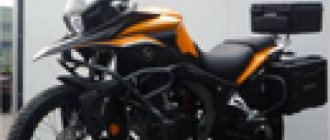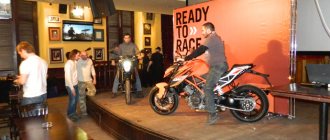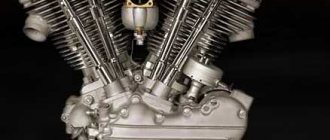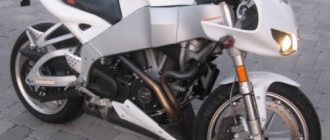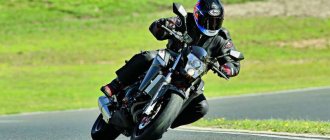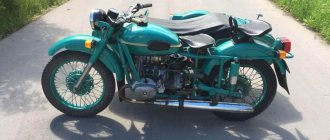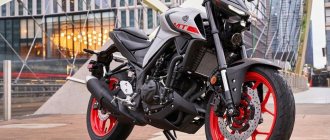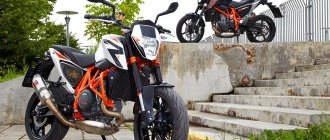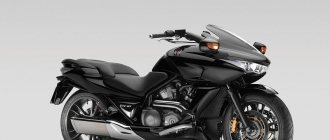RU-MOTO rating
- Reliability
- Chassis
- Appearance
- Comfort
4.5
Verdict
The impeccable quality of all elements and its own style place the Victory Hammer 8 ball model in the line of premium equipment. This is evidenced by the cost of the chopper. We can only hope that this colorful exclusive will appear on our tracks more often.
Victory
Hammer
motorcycles break the stereotype of the traditional cruiser with an unusual concept. A powerful engine, stylish design and color scheme with a minimal amount of chrome surfaces provided the model with a significant difference from its competitors. This is a bright, memorable bike with an aggressive character. Potential buyers will also be pleased with the price of the motorcycle.
Motorcycle Victory Hammer
Read other motorcycle reviews Around the world on the Victory Сross Сountry cruiser
Hummer ergonomics provide a comfortable fit due to a low center of gravity and a comfortable seat. A typical American looks stylish and defiant. In Russia, the motorbike is presented in a single configuration, which does not prevent us from supplementing its already luxurious appearance with tuning elements.
Specifications
The powerful engine of the Freedom 100/6 model with an electric starting system and injection type intake provides maximum opportunities for a comfortable ride.
Options:
- Engine – 2-cylinder, 1731 cc;1
- Transmission – 6-speed;
- Torque – 139 Nm at 2500 rpm;
- Fuel tank – 17 liters;
- Weight – 532 kg.
Victory Hammer Specifications
In America and Canada, the Victory
Hammer 8 ball
enjoys enviable success, in contrast to the Russian market, where the motorbike is not yet so popular. Unconditional power with an engine capacity of 1.8 liters ensures an instant start. A modern fuel system ensures that the engine is economical; during quiet driving around the city, fuel consumption is 6-6.5 liters.
Test drive Victory Hammer
It’s difficult to talk about the topic: “Which motorcycle to choose?” if you live in Ukraine, where, despite 2011, not all even the top brands of motorcycle manufacturers are still represented, and those that are represented often do not show themselves in any way - neither with advertising, nor even more so, with presentations of their models "actually". Result? Insignificant or even zero sales and a lot of stupid questions from potential buyers to specialists, including letters to our editor. There is a lack of awareness on the topic. Example? Easily! I think if you conduct an experiment and ask one hundred motorists what the Polaris concern produces, then no more than twenty-five will remember that they are snowmobiles, about ten will remember that they are also ATVs, and, at best, one will say: “and some motorcycles.” Yes, since 1997 Polaris began producing motorcycles in the USA under the Victory brand, but so far it is also far from the popularity of another American brand, which is known not only by motorists, but even by children in kindergarten, as Ukraine and Germany in terms of the volume of exports of high-tech goods .
Due to my line of work, I am obliged to follow news in the world of motorcycles, but I learned by chance at an exhibition that last year Polaris decided to sell Victory motorcycles in addition to snowmobiles and quads on our market, and this is despite the profile of my profession . What can we say about the “cross-border Ukrainians”? There was not just an advertising campaign, but not even an information campaign. Moreover, the importer still does not have the availability of motorcycles; they are brought exclusively to the client’s order, in isolated cases! To fill the gap about this “secret” brand in the information field of Ukrainians, I had to ride one of the representatives of the Victory family named Hammer, owned by a private individual.
The first thing I thought of with annoyance when I sat behind the wheel was the “feet first” seating position. In combination with the clumsy and often broken surfaces of our roads and streets, this is fraught with injuries to my sore spine, especially if the suspension cannot save me from impacts on my tailbone. Overall, the motorcycle is, of course, beautiful – you can feel the “hand of a master”. All lines are smooth and precise, as are the color combinations. Many are attracted by the “branded feature” from Victory: drilled and polished holes on the side plates, which are located between the cylinders. There's something about it, especially in contrast with the black color of the gas tank.
In general, if you take a closer look at the stock models, the company’s cunning policy will become clear, pushing the new owner to immediately begin replacing “not cool enough” stock parts with tuning ones from Arlen Ness. Moreover, this process is quite lengthy (and, like any tuning, expensive) - you need to start with the mirrors and finish with mufflers.
But it’s time to move further along the test and closer to our counterpart. In the left trim there is an ignition switch, after turning the key, multi-colored lights flash on a panel mounted in the upper cross-arm, and the tachometer and speedometer wells are illuminated with a pleasant greenish light. It’s strange, but before the engine comes to life and hums with its sharpened tuning mufflers, the starter buzzes for a long time, and the crankshaft manages to make more than a dozen revolutions, as if there are no injectors that instantly supply fuel, but ordinary carburetors. I still don’t understand whether this is the designers’ idea or a real defect. The first one turns on, as it should be “in class,” with a rich clatter, although, of course, it is far from Harley-like. The clutch lever, although a little tight, is quite informative and allows you to catch the “contact patch” and move away without adding gas. Further - more interesting. A V-shaped engine of such a volume cannot but have powerful traction, as they say, “from the bottom,” but in this case the engine is frankly “dull” until the tachometer needle creeps beyond the o. If you don’t drive it there right away, from the start, it will seem that two huge pistons are fighting each other for the right to be the first to push the crankshaft and at the same time they seem to stumble. In general, the acceleration of the Hummer is impressive, it is assertive and smooth, without catching, but... there is a huge difference in gear ratios between the first and second stages. Therefore, to achieve maximum acceleration, you should shift after the crankshaft reaches 4000 rpm. The gearbox operates harshly and noisily, probably this is also a tribute to style, but the fact that “catching” neutral at traffic lights also requires a certain skill, when driving in heavy traffic, begins to irritate. Although I didn’t notice any obvious blunders in the operation of the box (crunching of synchronizers, misconnections, false neutrals), even when switching without squeezing the clutch.
But one of the main components of the visual “steepness” of the model is the rear “skating rink” with a width of 250 mm, and even in combination with a long wheelbase, a large fork angle and wheel offset, the Hammer is, as they say, “under the monastery”: When entering a turn this “explosive mixture” can play a cruel joke on an inexperienced driver, since with such a combination of components the bike has acquired a non-linear turning characteristic, and it also changes depending on the amount of steering wheel turn and speed. “In nature” and when viewed from the outside, it looks quite cool: when turning the steering wheel at low speed and trying to tilt the motorcycle, it first desperately resists, and then, when the driver manages to tilt it, it begins to fall frighteningly sharply in the direction of the turn, forcing the driver to either add gas and straighten the trajectory, or... put your foot out and push off from the asphalt with it! In other words, maneuvering with a change of lane and direction on a Hammer in a dense jam or traffic jam is quite a challenge. Everything becomes somewhat simpler if the turning speed is more than 30 km/h, when the centrifugal force acquires some noticeable value and there is no longer any need to turn the steering wheel sharply; with experience, you can guide the motorcycle with your body. Then the motorcycle suddenly “submits”, ceasing to be willful and, although “not by the power of thought,” it tilts at a fairly decent angle without any problems, prescribing the desired trajectory (this can be seen in the photo). Hurray, the taxiing technique has been found!?
But no matter how it is. If the surface on the turning path is at least relatively smooth, then everything will be great. But if there are potholes or transverse-longitudinal sagging along the way, you won’t find it enough. The inverted fork does its job wonderfully, absorbing all significant irregularities, which, unfortunately, cannot be said about the monoshock absorber, which can be replaced with a spacer and the pilot will not feel much of a difference. Kicking in a turn with a wide rear “roller” and a tilted composition of more than 300-kilogram “piece of iron” and no less than a hundred-twenty-kilogram swearing “carcass” of the rider - what a spectacle! What if the asphalt is wet? That's the same... “NezachOt!” – as is customary to write on forums. Since “one time doesn’t count,” I deliberately made a loop along one crooked street on the left bank of the Dnieper, which has an asphalt surface that can be conditionally (for our cities) classified as “statistically average.” And he didn’t seem to be driving fast, within the limits of the traffic rules, and he was watching the choice of trajectory, but apparently he wasn’t paying attention well. At some point, moving in a straight line and not crossing a speed bump or any other obvious road irregularity, I received a “non-sour” blow to the spine, which caused such pain in the lower back that my vision went dark for a moment. Work is work, but after this treachery my patience was only enough for a photo shoot...
The Hummer also has brakes. Although fools claim that they were invented by cowards, it is impossible to ignore this important component of the safety of any motorcycle. There are no questions about the front one, it is quite powerful and quite informative (just take a closer look at its components, everything will become clear). But with the second part of the system, the designers went too far. It also cannot be blamed for insufficient productivity, but it is easy to blame it for excessive productivity. Even the 250th “skating rink” with its rather large contact patch falters on dry asphalt and skids if you do not carefully use your right foot, pressing on the paw.
Well, and finally – about the good. When I drove the Hammer, it seemed to me that its elaborate mirrors were just a clever design element. But no, after a minute of adjusting them to suit you, testing them with urban movements showed their complete “professional suitability”: both the viewing area and the clarity of the picture are quite at a level worthy of a good road worker, which is already a compliment for a motorcycle of this class.
The appearance, speed and dynamics of the motorcycle are certainly worthy of its status and will please the vanity of its owner. But it seems to me that the price/quality ratio, if viewed not through the prism of “show-off”, but from the point of view of functionality, is clearly not in favor of this “hammer”, which never managed to become a “hammer”, or - well done. And, no matter how much the leaders of “Victory Motorcycles” puff themselves up, declaring the creation of a “truly American cruiser”, in my opinion (and in fact too) in the markets of both the USA and Ukraine there are other motorcycles of the same class with no less high index of attractiveness, but with a higher component of practicality in its price. Although, as they say, “there are no comrades according to taste,” that’s why there is such diversity in the motorcycle world.
History of the Victory brand
It began in 1995, when the top management of the American concern Polaris Industries, known for its snowmobiles, aquabikes and quads, decided to invade the motorcycle market. The ambitions of the “leading comrades” of the company were so great that they announced the release of “real American cruisers,” as if they had produced fake ones in the USA before them. Already in 1997, the first model, V92C, was ready for serial production, which was officially presented on July 4, 1998. It was not just a national holiday - Independence Day, the fact is that on this day, 45 years ago, the production of Indian motorcycles was stopped and the management of the concern did not fail to declare that “for the first time in 45 years, the production of truly American motorcycles began in the United States motorcycles." What's the result? The business, which began with great fanfare, almost failed - a motorcycle with square cylinder fins, chrome peeling off the covers, controversial ergonomics and low reliability quickly lost interest among buyers (despite the fact that at that time its engine had the largest displacement among production motorcycles) , and dealers canceled contracts en masse. The situation was complicated by the appearance in the same year of the revolutionary V-Rod from Harley-Davidson, which was a success with buyers. Only a miracle could save the young Victory Motorcycles from bankruptcy. And the wizard who created it was the famous customization guru Arlen Ness. It cost the company's top managers work and money to persuade him to head the project, but with the process of “restructuring” and the emergence of new models, the situation gradually began to improve, sales went up. A turning point for the brand was 2002, when a new engine (with the same volume, but a more attractive design) called Freedom appeared, followed by the Vegas model, which marked a new stage in the development of the brand. It was followed by the Kingpin, and in 2005 the engine was increased to 100 cubic inches and the Hammer model was released. That same year, she was named "Best Cruiser of the Year" (according to Motorcycle Cruiser Magazine). But the flagship of the brand was the Vision luxury tourer, which appeared in 2008, and amazed everyone with its “cosmic” appearance.
Text: Valery Chuikov
Photo: Andrey Shlenchak
Equipment provided by: Yuri Pudenko
Hummer price
The new model can be purchased on the Russian market for RUB 1,517,820.
Read other motorcycle reviews New paints for BMW bikes in 2014
Used Victory Hammer Price Review
It is almost impossible to find this model on the secondary equipment market.
The Victory chopper is still a rarity on our roads. The model can only be purchased on order from America, and accordingly, all additional tuning elements will have to be ordered there. Although the future owner of the exclusive can be completely confident in the individuality of his device. The developers pay great attention to accessories that provide their own style and originality.
Advantages and disadvantages of Victory Hammer
The fact that the equipment is delivered individually already indicates the exclusivity of the model.
pros
- Quiet motor operation;
- Vibration is almost imperceptible;
- Carbon-reinforced belt (manufacturer declared mileage of 100 thousand miles);
- Powerful tires.
Minuses
- Problematic tire fitting;
- Tight clutch handle;
- High price;
For connoisseurs of style and luxury, a motorbike will definitely be a must-have.
VICTORY Kingpin, cruiser
Year of release 2007 | Engine 1634 smz | Power about 85 hp. | Weight 297 kg | Estimated price (US) $16,900
Guess three times which company Victory has to compete with? That's right, the one whose motorcycles are equipped with V-twin engines, and she herself is called legendary. Wow rival? So that all SMZ, interested Russians could feel how Victory is going to beat its competitors, we, Russian motorcycle journalists, were invited in the middle of winter to the business capital of the United Arab Emirates - the ever-hot city of Dubai, on the coast of the Persian Gulf to test new motorcycles, so that we, naturally, would tell about all those who are interested. In fact, don’t roll it around frozen Moscow using de-icing agents: it’s somehow unpleasant - the grip is disgusting.
It is not yet known for certain which models our distributor Polaris will sell, but the Americans rolled out modifications of the Hammer and Kingpin for testing. They differ from each other in that the first is a cruiser, similar to a chopper, and the second is definitely a cruiser, respectively, with wheels and design. The Kingpin doesn't have a tachometer, the Hammer does. Why is another question, but let it be - you can’t spoil the porridge with butter. That's where the technical differences end.
The entire Victory lineup is powered by one engine—the Freedom V-twin (that’s what it’s modestly called). In order not to bore you with technical details, let’s talk about the hardware very briefly. The engine is by no means ordinary in technical content: 100-inch (1634 cc), cylinders are “square” in size (101x102 mm), and the cylinder camber angle is 50°. Competitors have more genuine pistons and a smaller angle. The heads are 4-valve, with hydraulic compensators, the camshafts are driven by chains. The fuel is dosed by the injection system. The clutch is “wet”, multi-disc, the gearbox is 6-speed. Only the reverse gear corresponds to the canons of the style - with a belt (although it has Kevlar threads stretched through it). There is no smell of archaic here - everything is very modern!
The name Hammer is forced to “inspire” - it smacks of cool a mile away. The device is 100% identical in appearance - from the “tail” with a 250 mm cylinder to the “nose” 18-inch wheel. For real, chopper! Or bobber? Or maybe it’s still a cruiser?..
The very first short familiarization trip before the two-day run shattered the usual stereotypes. This V-alternative accelerates (you already know why) like a car prepared for drag racing. Test braking almost led to a fall: the brakes grab tightly (two O 300 mm discs with Brembo brackets)! Moving over several speed bumps demonstrated the perfect operation of the suspensions - an inverted one at the front and a gas-filled monoshock with a progression at the rear. The thoroughbred roar of the V-twin is impressive (the torque curve illustrates the engine’s extraordinary dynamic capabilities; you’ll be even more impressed if you think about the 6-speed gearbox). That's it, alles, we made it - a racing chopper! And where is the world heading?..
Premier test - V-alternative
